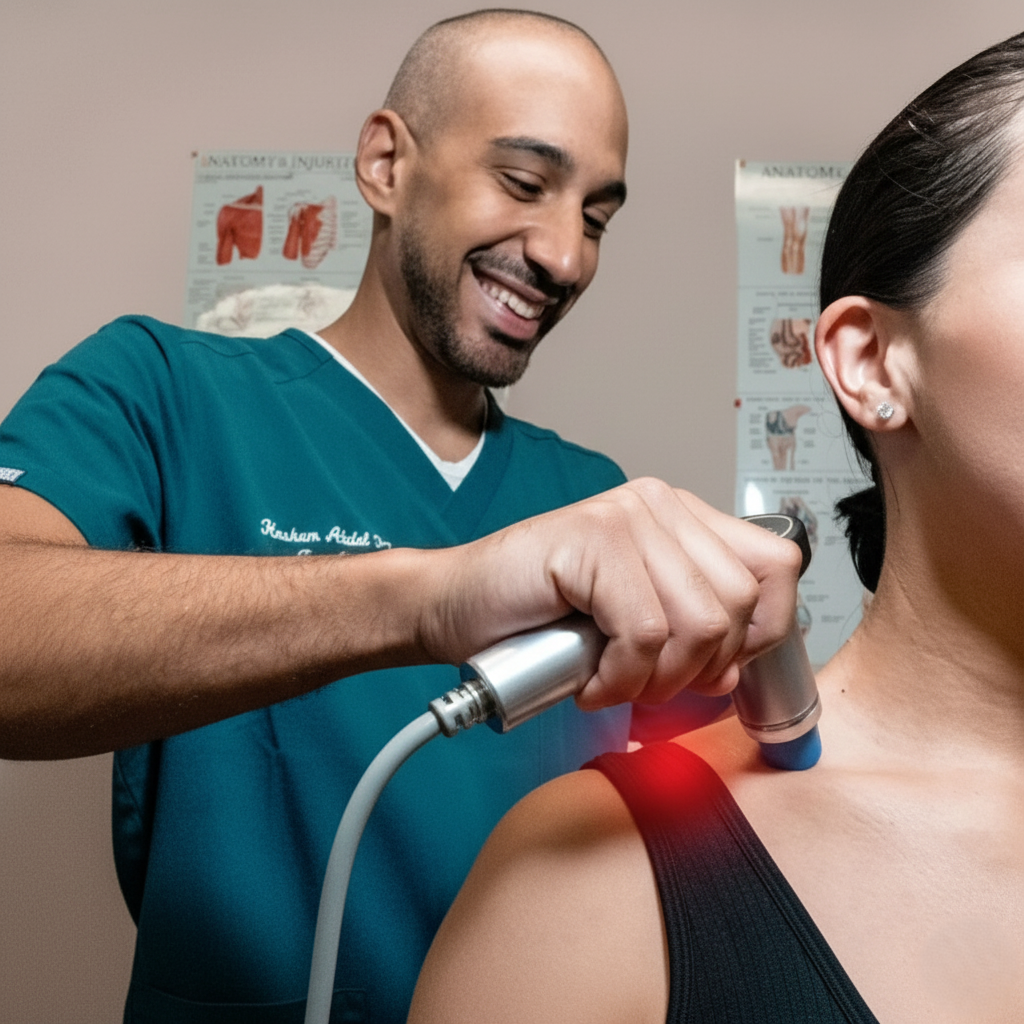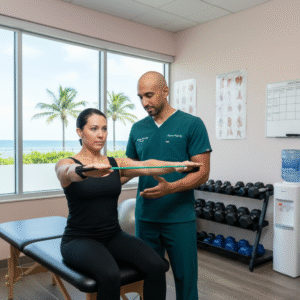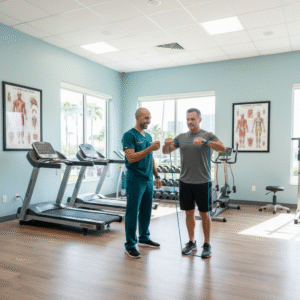When people hear the term shockwave therapy, it’s natural to imagine something intense or painful. The word “shockwave” alone sounds intimidating, but in reality, this innovative treatment is far more comfortable and beneficial than many expect.
At our TheraCave, we specialize in providing professional shockwave therapy designed to relieve chronic pain, improve mobility, and accelerate recovery. If you’ve been avoiding treatment because you’re worried it might hurt, this article will help clear up any misconceptions and walk you through what to expect during and after your session.

What Is Shockwave Therapy?
Shockwave therapy, also known as Extracorporeal Shockwave Therapy (ESWT), is a non-invasive medical treatment that uses high-energy acoustic waves to target injured or inflamed tissues in the body.
These sound waves help:
- Break down calcium deposits
- Improve blood flow
- Stimulate natural healing processes
- Reduce inflammation and chronic pain
It’s widely used to treat conditions such as plantar fasciitis, tendinitis, tennis elbow, shoulder pain, and chronic muscle stiffness.
Unlike surgery or steroid injections, shockwave therapy requires no downtime, meaning patients can return to normal activities almost immediately after treatment.
The Sensation During Shockwave Therapy
The most common question patients ask before booking a session is: “Does shockwave therapy hurt?”
The short answer: it may cause mild discomfort, but it’s not painful.
During the procedure, the practitioner applies a handheld device to the treatment area. This device delivers a series of focused pulses that penetrate deep into the tissue.
Here’s what you might feel:
- A tapping or pulsing sensation on the skin.
- A mild ache or pressure in the affected area.
- Temporary tenderness, especially if the injury is severe or inflamed.
For most patients, the discomfort is comparable to a deep tissue massage, noticeable but tolerable. And in nearly all cases, the discomfort lessens as the session progresses because the treatment stimulates circulation and reduces muscle tightness.
Factors That Influence Pain Level
Not every patient experiences shockwave therapy the same way. The sensation can vary based on several factors, including:
- Pain Tolerance:
People with higher sensitivity to touch may experience slightly more discomfort during initial sessions. - Treatment Area:
Areas with less fat or muscle padding (like the heel or elbow) tend to be more sensitive than fleshy regions like the thigh or shoulder. - Intensity Settings:
Professional clinics customize energy levels based on your comfort and the severity of your condition. - Type of Shockwave Therapy:
- Radial shockwave treats broader, superficial areas.
- Focused shockwave targets deeper tissues and may cause more noticeable sensations.
At TheraCave, our trained professionals always begin with a low-intensity setting, gradually increasing power only if the patient feels comfortable.
Post-Treatment Sensations – What to Expect
After your first session, it’s normal to feel slight soreness or tenderness in the treated area. This typically lasts between 24–48 hours and is similar to the feeling after a good workout.
This mild inflammation is actually a sign of healing, as your body begins repairing tissues and improving blood circulation. Most patients find this sensation completely manageable, and it usually fades without any need for medication.
Some report an immediate reduction in pain, while others notice gradual improvement after a few sessions as the treatment builds cumulative benefits.
Managing Discomfort During and After Treatment
If you’re concerned about discomfort, here are a few ways clinics (like ours) make your experience as pleasant as possible:
- Customized Treatment Intensity: We always start at a comfortable level and adjust only with your consent.
- Short Session Times: Each session lasts just 10–15 minutes per area, minimizing any potential irritation.
- Use of Ultrasound Gel: The gel reduces friction and helps transmit shockwaves smoothly.
- Guided Breathing Techniques: Light breathing can help patients relax during treatment.
- Post-Treatment Ice Application: Some patients find gentle icing for 10–15 minutes helpful for soreness.
You can also discuss pain management options with your practitioner before starting your therapy plan to ensure maximum comfort.
Why It’s Worth It – The Benefits Far Outweigh the Discomfort
While it’s natural to be cautious about any new treatment, most patients agree that the minor discomfort of shockwave therapy is a small price to pay for the lasting relief it delivers.
Here are the top benefits:
Non-surgical and drug-free
Accelerates healing and tissue regeneration
Improves blood flow and reduces chronic inflammation
No anesthesia or recovery time required
Restores movement and reduces stiffness
High success rate in treating chronic musculoskeletal pain
Many people notice significant improvements after just 3–5 sessions, depending on their condition and lifestyle.
Comparing Shockwave Therapy Pain to Other Treatments
If you’ve tried other therapies, here’s how shockwave therapy stacks up in terms of discomfort:
| Treatment Type | Pain Level (1–10) | Notes |
|---|---|---|
| Deep Tissue Massage | 4–6 | Temporary soreness may occur |
| Dry Needling | 5–7 | Involves minor needle pricks |
| Cortisone Injection | 7–8 | Short, sharp pain at injection site |
| Surgery | 9–10 | Requires anesthesia and recovery |
| Shockwave Therapy | 3–5 | Mild, short-term discomfort only |
As you can see, shockwave therapy is one of the least painful yet highly effective options for treating soft tissue injuries and chronic pain.
Who Should Consider Shockwave Therapy?
Shockwave therapy is suitable for anyone dealing with:
- Plantar fasciitis (heel pain)
- Tennis or golfer’s elbow
- Shoulder or rotator cuff pain
- Hip bursitis
- Chronic tendon or muscle pain
Whether you’re an athlete recovering from overuse injuries or an individual with long-term joint discomfort, shockwave therapy offers a safe and clinically proven way to heal naturally.
Professional vs. At-Home Devices – Why Expertise Matters
Some people look for at-home shockwave devices online, but it’s crucial to understand that professional shockwave therapy cannot be replicated with consumer-grade tools.
Here’s why you should always choose a licensed clinic:
- Professionals use FDA-approved, medical-grade equipment.
- Treatment is personalized to your body and pain level.
- Incorrect use at home can lead to bruising or ineffective results.
- Clinics follow strict hygiene and calibration standards for safety.
When performed by a certified provider, shockwave therapy is safe, effective, and worth every session.
Final Thoughts
So, how much does shockwave therapy hurt?
In most cases, very little. While mild discomfort may occur, it’s brief and manageable. The benefits, however, can be life-changing, offering lasting pain relief, faster recovery, and a stronger, healthier body.
Call to Action – Book Your Shockwave Therapy Today
If chronic pain is holding you back, don’t wait another day. At TheraCave, our experienced specialists provide gentle and effective shockwave therapy tailored to your needs. We’ll guide you through every step, ensuring you’re comfortable and confident throughout the process.
Call us today or book your appointment online to experience the relief and recovery your body deserves, without surgery or long recovery times.






